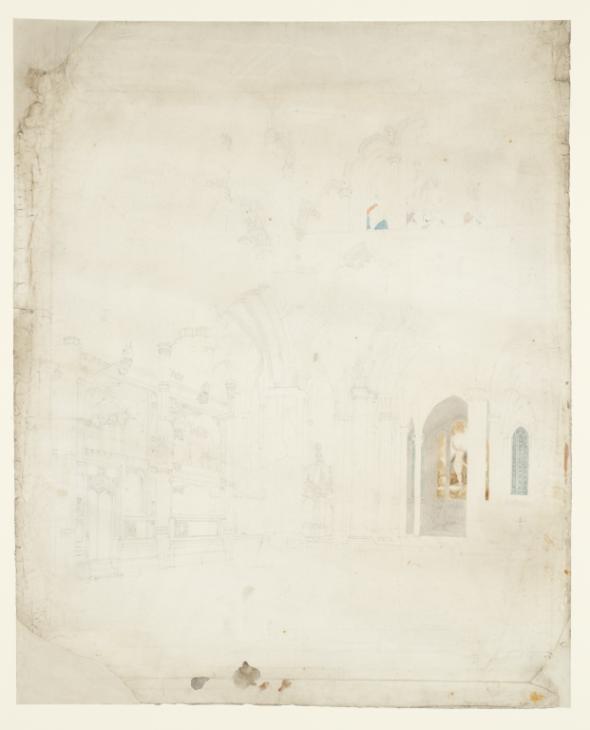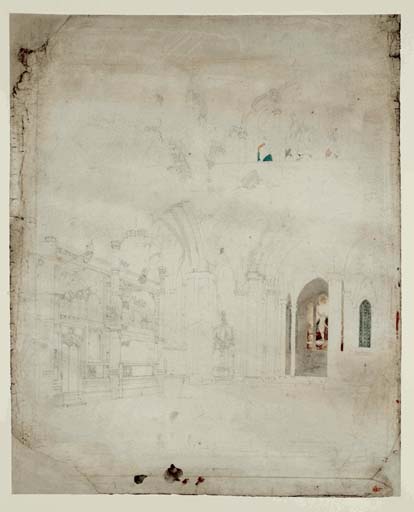Joseph Mallord William Turner Salisbury Cathedral: The Choir, Looking East towards the Lady Chapel c.1797
Image 1 of 2
Joseph Mallord William Turner,
Salisbury Cathedral: The Choir, Looking East towards the Lady Chapel
c.1797
Joseph Mallord William Turner 1775–1851
Salisbury Cathedral: The Choir, Looking East towards the Lady Chapel c.1797
D02345
Turner Bequest L D
Turner Bequest L D
Pencil and watercolour on white wove paper, 690 x 550 mm
Watermark ‘Whatman’
Blind-stamped with Turner Bequest monogram bottom right
Stamped in black ‘L – D’ bottom right
Watermark ‘Whatman’
Blind-stamped with Turner Bequest monogram bottom right
Stamped in black ‘L – D’ bottom right
Accepted by the nation as part of the Turner Bequest 1856
References
1909
A.J. Finberg, A Complete Inventory of the Drawings of the Turner Bequest, London 1909, vol.I, p.126, L D, as ‘Salisbury Cathedral: the Choir – looking East.’ c.1799–1801.
This is a preparatory study for the watercolour of this subject exhibited at the Royal Academy in 1797 and now in the Salisbury and South Wiltshire Museum,1 one of a series executed on commission for Sir Richard Colt Hoare. Turner’s notation of complex Gothic architectural detail is masterly, though economical of means. Technically, it is a development of his work at, for example, Ely in 1794; see Tate D00369 (Turner Bequest XXII P) above. In blank space at the upper left he has inserted carefully observed details of the triforium and clerestory. His use of colour to record the stained glass in an otherwise uncoloured drawing is paralleled in his drawings of the interior of New College Chapel, Oxford (Tate D02346, D02347; Turner Bequest L E, F).
The upper window, depicting Moses and the Brazen Serpent, was designed by John Hamilton Mortimer (1740–1779). The large Lady Chapel beyond the choir is also known as Trinity Chapel. Its window showing the Resurrection, depicted by Turner, is no longer extant; executed in stained glass by Francis Eginton (1737–1805) after a design by Sir Joshua Reynolds (1723–1792), it was installed in 1788, but removed and probably destroyed in 1854.2 Turner also allows us to glimpse the richly ornamented Mannerist-cum-Baroque monument in the retrochoir of Sir Thomas Gorges, erected in 1635, which he depicts in considerable detail, with its twisted corner columns and crowning polyhedron. James Wyatt’s alterations at Salisbury in the early 1790s included the removal of seating in the Lady Chapel, and of a screen between the Chapel and the Choir; Turner’s view records the consequences of these alterations.3
Technical notes:
There is a ruled pencil border. The sheet is stained and torn, with grey, red and brown colour trials in the lower margin.
Verso:
Blank; not stamped.
Andrew Wilton
March 2013
How to cite
Andrew Wilton, ‘Salisbury Cathedral: The Choir, Looking East towards the Lady Chapel c.1797 by Joseph Mallord William Turner’, catalogue entry, March 2013, in David Blayney Brown (ed.), J.M.W. Turner: Sketchbooks, Drawings and Watercolours, Tate Research Publication, April 2015, https://www


